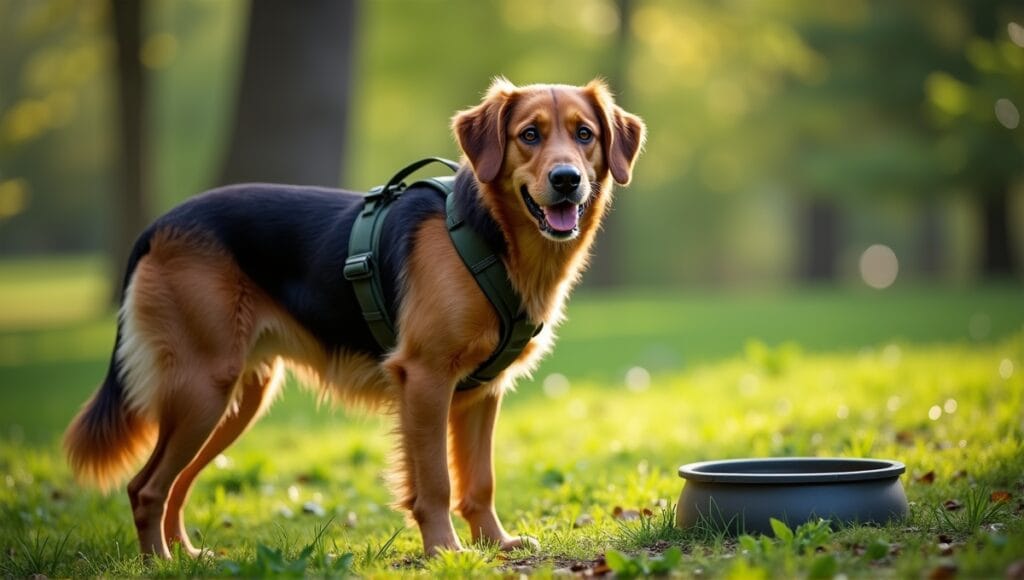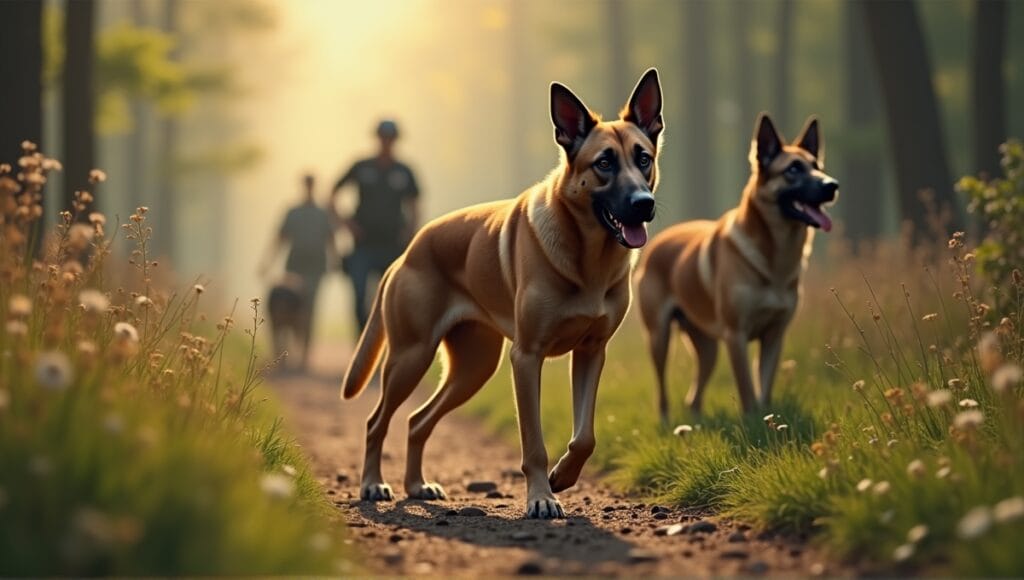Dogs are incredible at tracking, and I have studied and worked with tracking dogs of all breeds for many years. So, which dogs are the best tracking dogs?
I’m going to discuss the best tracking dogs based on my own experience working with these amazing dogs. Their noses are truly something special, so let’s talk about the breeds that excel at tracking and why.
Top Tracking Dog Breeds

Tracking dogs are in a category of their own, and I’ve dedicated years to studying them and their incredible capabilities. Here are the top breeds:
Bloodhounds are the top dogs when it comes to scent tracking. There’s just no competing with their noses. This larger droopy-eared breed can track scents that are days old, and they’re notorious for their determination.
German Shepherds are excellent all-around working dogs. They’re highly intelligent and have a great sense of smell, which is why they’re often the top choice for police dog breeds. German Shepherds are also known for their versatility and are often used in military work.
Beagles have perhaps the most powerful nose for their size. In other words, don’t underestimate this smaller hound. They’re also excellent at ground scent tracking.
Basset Hounds are another breed built for ground scent tracking. Their droopy ears help push scent toward their nose, and their short legs keep them low to the ground with the scent.
Coonhounds are skilled at treeing game. You’ll know if a Coonhound is in your area based on its distinctive bay. They’re the best at tracking small game through heavy woods.
Pointers are fantastic trackers and indicaters. The breed is also famous for their motionless ‘point’ when they find game, which is incredibly helpful for hunters.
The main traits each breed possesses are:
- Bloodhound: Amazing nose, endurance, determination
- German Shepherd: Versatility, intelligence, trainability
- Beagle: Small size, determination, focus on ground scent
- Basset Hound: Physical attributes that aid in scent tracking, determination
- Coonhound: Ability to tree, unique vocalization, heavy wood tracking
- Pointer: Accurate tracking, indicating, hunting tracking partner
Anatomy of a Tracking Dog’s Nose
A tracking dog’s nose is a true wonder of the world. I’ve witnessed the power of these amazing noses firsthand.
Dogs have as many as 300 million olfactory receptors. In comparison, humans only have about 6 million. That is an astounding difference. It’s no wonder dogs can detect scents we can’t even comprehend.
A dog’s brain allocates about 40% of its sensory cortex to analyzing scents. In humans, that number is just 5%. Dogs simply smell more, and they also process scents in more detail.
Moisture in a dog’s nose is essential. This moisture helps collect scent particles, and then the wet surface retains them long enough to analyze them more thoroughly.
Dogs can actually determine which nostril a scent make first contact with. This exceptional ability allows them to accurately backtrack where the smell originated.
[Insert a diagram of a dog’s nasal anatomy]
Historical Development of Tracking Dogs

Tracking dogs have a long and storied history. I’ve always found their evolution fascinating.
The earliest breeding efforts were focused on creating St. Hubert’s Hounds, which were the ancestors of today’s Bloodhounds. Monks in Belgium developed the breed during the 8th century.
Over time, specialized tracking breeds emerged as different regions of the world bred dogs for their specific tracking needs. This is why we have so many different tracking breeds today.
In the late 19th century, tracking dogs were then introduced into law enforcement. Police officers in both Europe and America realized they could use these dogs to solve crimes. This was a significant turning point in their history.
Today, tracking dogs are heavily relied upon in search and rescue missions. They’re able to find missing people who are lost in a wide range of terrains, making them an incredibly valuable asset. They’ve likely saved thousands of lives.
Here are some of the key milestones:
- 8th century: St. Hubert’s Hounds developed
- 16th century: Bloodhounds used in Scotland for tracking criminals
- 1888: First documented use of police dogs in London
- 1899: Belgian Malinois established as a breed ideal for police work
- 1970s: Establishment of search and rescue dog programs worldwide
Training Techniques for Tracking Dogs
Tracking dog training is part art and part science. I’ve trained countless dogs over the years, and through trial and error, here’s what I’ve learned:
Train them young: I’ve found the best age to start training tracking dogs is around 8-12 weeks. At this age, puppies are very curious and eager to learn. It’s an open slate of a mind to install tracking basics.
Start with basic obedience and basic scent work. Use play as much as possible so training feels like a game. Reward puppies early on for following simple scent trails. This will become part of a game with your puppy, which is very fun (and easy).
Eventually, work up to more challenging scent trails and to more challenging scent scenarios. What’s more, increase the scent age and the scent distance. And begin introducing basic scent distractions.
Ongoing maintenance sessions are key with working dogs, you slightly being a dog out of itself into a working state. Plus, regular practice sessions will ensure a solid bond between both you and the dog.
Main steps to training:
- Scent introduction through play
- Train a dog to follow a straight scent trail
- Work a dog for turns and trail crosses
- Begin to add scent age and distance to a trail
- Add a few simple scent distractions
- Regular practice to maintain training
While tracking dogs are often associated with police work, it’s worth noting that many therapy dog breeds also undergo specialized training to provide comfort and support in various settings.
Tracking Dog Abilities and Limitations

Tracking dogs are impressive animals, but they also have limitations. Knowing these limitations is important.
Scent age accuracy depends on the breed and specific training. Some dogs can track scents that are several days old, while others can track scents up to two weeks old (Bloodhounds are known for their ability to track scents that are two weeks old).
Range accuracy also depends on the dog breed. Many tracking dogs can track for miles, and some have been known to track for over 100 miles. However, this is contingent on many factors such as terrain and weather, and the range will be much shorter in most cases.
Environmental factors (heat, humidity, wind, etc.) significantly impact tracking.
Dogs typically work for about 7-10 years before they retire. Some work longer than this, but that’s usually when they start to slow down or lose motivation.
Table outlining each breed and its tracking capabilities:
| Breed | Scent Age | Max Range | Ideal Terrain |
|---|---|---|---|
| Bloodhound | 2 weeks | 130 miles | Versatile |
| German Shepherd | 1 week | 40 miles | Urban |
| Beagle | 2-3 days | 15 miles | Field/Forest |
| Basset Hound | 1 week | 20 miles | Low vegetation |
| Coonhound | 3-4 days | 30 miles | Dense forest |
| Pointer | 1-2 days | 25 miles | Open field |
It’s interesting to note that while some tracking dogs excel in specific terrains, herding dog breeds often have excellent tracking abilities as well, especially in open fields and farmlands.
Legal and Ethical Considerations
There are legal and ethical considerations to using a tracking dog. It’s a complicated topic I’ve researched extensively.
The admissibility of tracking dog evidence varies. Some courts allow it, while others are more skeptical. The handler’s experience often plays a significant role.
The ethical use of tracking dogs in law enforcement is a popular discussion. There’s a lot of debate about whether and how to use tracking dogs. Balancing public safety and individual rights is the main concern.
Animal welfare is a major concern with working dogs. Make sure the dog receives adequate care, food, and rest. If you overwork the dog, it will become burned out or injured.
There are regulations for tracking dog use. These regulations apply differently in each country and even in each state/province. The regulations discuss everything from training to certification to how the dog operates.
Care Requirements for Working Tracking Dogs

Caring for working tracking dogs is tough. I’ve cared for many tracking dogs over the years, and here’s what I’ve learned:
Nutrition is key for these high-energy dogs. They require a high-protein, high-fat diet to fuel their long hours of intense physical exertion. Consult a vet to ensure you’re feeding them the right foods.
Exercise and mental stimulation are a must. They need a mix of physical and mental exercise to keep them sharp and prevent boredom.
Regular vet check-ups are essential. These dogs are athletes, and like any athlete, they need regular health check-ups. These dogs work incredibly hard, and it’s important to catch any health problems early.
Proper rest between activities is key. These dogs work very hard for a living, so just make sure they have enough time to rest and recover.
Sample daily schedule:
- Feed high-quality, balanced meals 2-3 times per day
- 1-2 hours of exercise, including giving them jobs or training sessions
- Mental stimulation tools or scent games
- Grooming them to check for health issues
- A comfortable place to rest in peace and quiet
- Fresh water at all times
While tracking dogs require specialized care, many of these principles apply to other working dogs as well. For example, retriever breeds often have similar exercise and nutrition needs due to their high energy levels and work ethic.
Before We Go
Tracking dogs are truly remarkable creatures with exceptional skill sets. I’ve witnessed the power of their noses and training to deliver some incredible results. And now you have a comprehensive overview of these unique breeds, their background, and the jobs they perform. Just remember to always take good care of them and treat them ethically, as they work very hard for you. Whether you’re simply intrigued by their abilities or thinking about working with tracking dogs, you now know everything you need to about them. These dogs are a great example of the amazing things humans and dogs can accomplish together.






